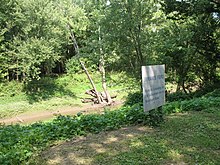| Battle of Byram's Ford | |||||||
|---|---|---|---|---|---|---|---|
| Part of the American Civil War | |||||||
 Modern view of Byram's Ford | |||||||
| |||||||
| Belligerents | |||||||
|
|
| ||||||
| Commanders and leaders | |||||||
|
James G. Blunt (October 22) Alfred Pleasonton (October 23) |
Joseph O. Shelby (October 22) John S. Marmaduke (October 23) | ||||||
| Units involved | |||||||
|
Blunt's division (October 22) Pleasanton's division (October 23) |
Shelby's division (October 22) Marmaduke's division (October 23) | ||||||
The Battle of Byram's Ford (also known as the Battle of Big Blue River and the Battle of the Blue) was fought on October 22 and 23, 1864, in Missouri during Price's Raid, a campaign of the American Civil War. With the Confederate States of America collapsing, Major General Sterling Price of the Confederate States Army conducted an invasion of the state of Missouri in late 1864. Union forces led Price to abandon goals of capturing the cities of St. Louis and Jefferson City, and he turned west with his army towards Kansas City.
On October 22, Price's army found itself caught between two Union forces, commanded by Major Generals James G. Blunt and Alfred Pleasonton. Part of Price's force conducted a delaying action against Pleasonton in the Second Battle of Independence, while the division of Brigadier General Joseph O. Shelby broke Blunt's line at Byram's Ford on the Big Blue River by crossing at an unguarded ford above the Union defenses. The Union defenders were forced to retreat to the Kansas state line, and the 2nd Kansas State Militia Infantry Regiment was caught at the Mockbee Farm and overwhelmed. Meanwhile, Pleasonton's men pushed Price's rear guard across the Big Blue in the Second Battle of Independence.
On October 23, Pleasonton attacked Confederate forces under Major General John S. Marmaduke at Byram's Ford and forced them back to a height known as Potato Hill. Pleasonton broke through Marmaduke's position, and the rest of the Confederate army was defeated at the concurrent Battle of Westport. While Price's wagon train escaped from Union Brigadier General John McNeil and his brigade, the Confederate army withdrew southwards in disorder. After suffering further defeats along the way, Price's army reached Texas by December, having lost over two-thirds of its men. The Confederates also lost equipment and supplies, while the Union war effort was only minimally hampered; the campaign was the last major operation west of the Mississippi River. Part of the battlefield is preserved in the Big Blue Battlefield Park, and a portion is listed on the National Register of Historic Places as part of the Byram's Ford Historic District.
- ^ Kennedy 1998, p. 383.